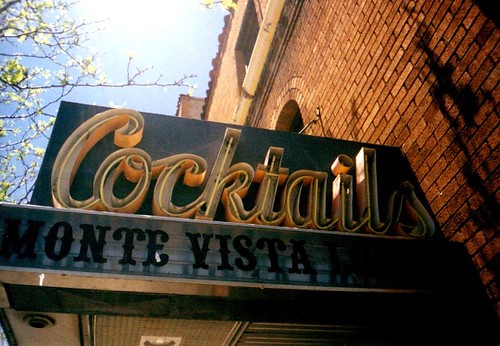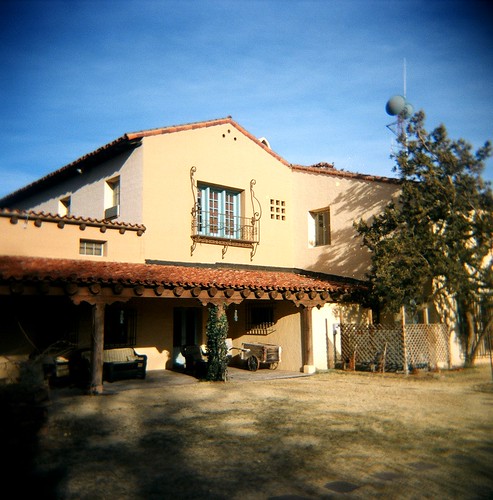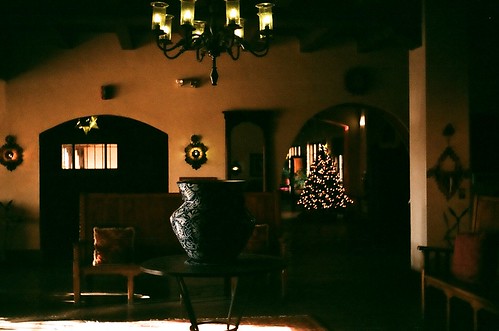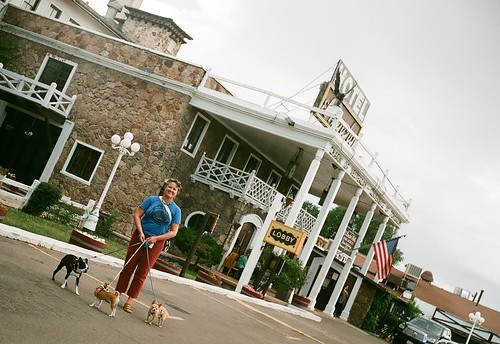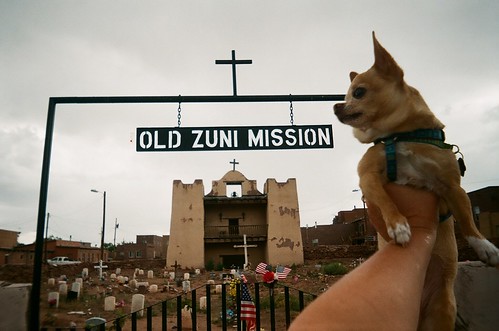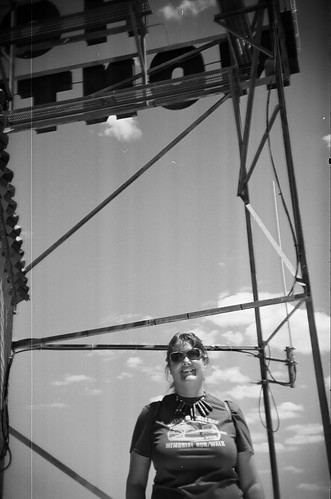A Fascination with Historic Hotels and Motels.
Ellen Jo Roberts
November 2012
 |
| "Ellen @ Monte Vista" ©10/96 Debbie Leavitt |

Check-In Time:
A Fascination with Historic Hotels and Motels.
Ellen Jo Roberts
I have history
with historic hotels. My first job upon arrival in Arizona was working the
front desk day shift at Flagstaff’s famous Hotel
Monte Vista. Affectionately known as The
Monte V or simply The V in local
vernacular, the massive brick structure has firmly shored up the city’s
downtown since it first opened in January of 1927. There is something beautiful
and sinister all at once about that grand ol’ dame. Heavy energy. Haunted,
sure. Legendary stories oft-repeated, and many famous guests and wild nights
adding to the intrigue. A crossroads of
European tourists, Navajo and Hopi, musicians, bar patrons, college
students, hobos, old-time locals having daily breakfast in the cafe, off track
bettors playing the ponies and average travelin’ folk made the hotel a colossal
vortex of magic in my world. The late
night lounge scene and high lonesome train horns certainly added something to
the mix.
Soon, the only surprise was a day when nothing surprising happened.
The guests and their stories, a clash of randomness and coincidence. The hotel
staff who alternated from being tightly-wrapped like family to hissing and
spitting at each other like alley cats. I sometimes felt like an extra in a
movie, orchestrating a concerto of check-outs and check-ins, decked in pencil
skirts and pearls, playing 1940s tunes and Nuyorican jazz on cassette. The rooms were mostly named after the famous
guests who had slept there, including Michael Stipe and Bon Jovi, and each had
their own quirk, angle, view, perks. Windows could be opened to access the
mountain breeze above and the street sounds below. From my years spent in the
cinematic lobby of a historic hotel I am forever stuck on vintage lodging. Such
places always have the best neon signs. No fresh construction or easy parking
for us. No anonymous chain motels. We prefer to share space with the memories
of the thousands who slept there before us. Luckily, our region is chock full
of historic accommodations both high and low brow.

I always think of La
Posada during the winter, as we spent one cozy Winslow Christmas there with
friends and dogs, playing board games in the great room, warmed by the
fireplace and whiskey-spiked egg nog.
One of the few remaining Harvey House
railroad hotels, La Posada was rescued from destruction by creative California
couple Allan Affeldt and Tina Mion in the 1990s. Tearing away the false
ceilings and walls, installed when the building was converted to office space
for the Santa Fe Railway, bit by bit the architectural glory of Mary Elizabeth
Jane Colter’s 1929 grand design was restored. The real appeal of La Posada is
the wealth of public space both indoors and out: cozy reading nooks and seating
areas, fine art, shelves full of coffee table books to borrow, and in recent
years, lush gardens, broad lawns and al fresco hideaways.
Trains both freight
and passenger cruise past regularly, punctuating your world class dinner at the
hotel’s Turquoise Room. La Posada is like its own island, its own
self-contained nation in a threadbare location. Winslow (once on track to
become The Next Santa Fe before
travel patterns changed from railroad to highway and airline) does become more
interesting and artistic each year, expanding beyond The Eagles’ “Standin’ on a
Corner” nostalgia. Travelers from all over the world visit La Posada, adding to
the sophisticated atmosphere.

Have
you slept in a Wigwam lately?
We have. It was slightly pointy and totally fantastic.
From the 1930s ‘til the 1950s there were seven Wigwam Villages nationwide, each
featuring a row of the same concrete tipi-shaped cabins, inspiration for the
“Cozy Cones” of Disney’s “Cars”. Now only three villages remain: No. 2 in Cave
City, Kentucky, No. 7 in Rialto, California, and Wigwam Village No. 6 in our very own Arizona. Route. 66,
Holbrook. Holbrook’s Wigwam Motel has
been owned by the same family for six decades, and it’s consistently booked
full, a popular overnight spot for Europeans touring the Mother Road. The parking lot is decorated with sun-faded
automotive relics parked at each wigwam, enhancing the sensation of
time-travel. Holbrook is friendly, with a good archive of Route 66 artifacts
and roadside dinosaurs, but there’s not much happening to keep the average
city-slicker engaged beyond the nearby Painted Desert and Petrified Forest
National Parks. Onward east on 66, to New Mexico, and just over the border into
Gallup.
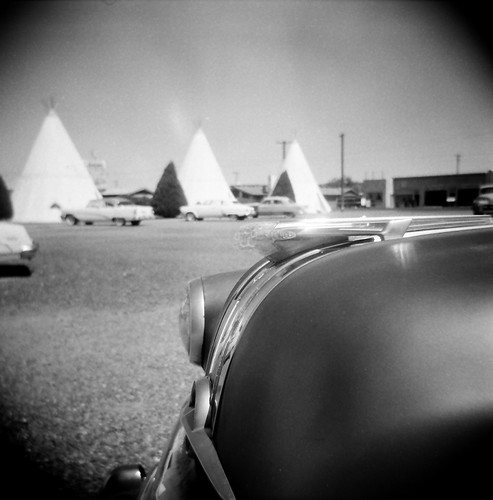
“The Charm of
Yesterday and Convenience of Tomorrow” can be yours at Gallup’s El Rancho Hotel. Built in 1937 by the
brother of the Hollywood director D.W. Griffith, the hotel served as base camp
for movie crews and stars on location in New Mexico during the hey-day of
western films. Its script neon sign is the only 20th century touch
to the exterior, built to resemble a wealthy western rancho of stone, brick and
Spanish tile. The rooms share some famous guests with the Monte Vista; Spencer
Tracy, John Wayne, Humphrey Bogart have their names emblazoned on doors, as do
a lengthy collection of other midcentury celebrities, including Ronald
Reagan. On our most recent visit we
stayed in the Betty Grable room, named after a 1940s actress most famous for
her fantastic gams.
Like most of the hotels we visit, El Rancho is
pet-friendly, so your dog is welcome to join you for no additional fee (though
you do need to mention your pets when booking). An impressive two story lobby
features a wishbone-shaped staircases wrapping around a stone hearth and is
decorated with Navajo art, elk heads and hundreds of framed black and white
autographed head shots of El Rancho’s famous visitors.
A player piano
entertains folks as they enjoy a card game and their iced-teas. The upper deck opens to a front veranda, a
vantage point to enjoy views of Route 66, Interstate 40 and the BNSF railroad
passing by all at once. El Rancho is a real place, a beating heart of Gallup,
and a favorite with the locals who utilize the restaurant and its adjoining
1960s-flavored Andalusian Room
banquet hall for their special events. During our most recent stay, a large
family celebrated a noisy Sweet 16 birthday party, dance music and balloons
cascading out past the restaurant and tumbling into the lobby.
Gallup is
somewhat lonely and the streets, even downtown, are empty most days, except for
a regular flow of panhandlers. Route 66 beggars of the west are generally
non-aggressive, but that’s counterbalanced by the sheer number of them. Often
times they offer a very specific reason why they need your money…. “I need to
get to Flagstaff.” “I need minutes for my phone.” If you say no they don’t offer any resistance
other than a pained expression and pleasantly walk on.

Gallup is famed as a trading center for the bordering
Navajo and Zuñi tribes. A visit to the Zuñi Pueblo is recommended for anyone in
the vicinity. Thirty miles through sagebrush-scented landscape brings you to
the compact pueblo. Adobe structures of varying vintages crowd the hilly
community. A photography permit may be purchased at the visitor center for
$10.00 per day, allowing you to snap images of the monolithic “Corn Mountain”,
also known as the Zuñi stronghold Dowa
Yalanne, and the adobe exterior of the old Zuñi Mission, a classic symbol
of New Mexico-style Christianity. The A:shiwi
A:wan Museum and Heritage Center is a wealth of information on the tribe,
ranging from historic films to modern art and future goals.
The sunny southwest is a harsh climate, but history
preserves well here. A cruise along
Arizona’s Highway 60 in any direction is a museum of sun-baked neon
signage. Classic cars fade from UV rays
but not rust. Historic buildings are never damaged by hurricanes or
earthquakes. If it’s built solidly, a desert structure can live on and remain
useful for centuries. Locally, Jerome is home to several classic overnight
options, including the 1898-built Connor
Hotel, well-maintained and regularly restored, anchored on the corner by
its popular Spirit Room bar. Though
21st century Jerome features a great variety of vintage lodging
possibilities, the Connor may be its only remaining hotel originally built as a
hotel. The oldest continuously-operating business in Cottonwood, since 1917, is
Old Town’s Cottonwood Hotel, best
known as a place where Elvis once rested his pompadour.

Historic lodging is often times less expensive than modern
chains, simply due to their lack of 21st century amenities and their
propensity for hobo sightings in the lobby. They’re odd, sometimes spooky, and
definitely native to their locations. You may have strange dreams. You can check out any time you like but you
can never leave. A historic hotel is always a treasure, with its strange
idiosyncrasies, rowdy cocktail lounge, ghosts and awkwardly-shaped bathrooms. A
recurring character starring in much of the town’s history, celebrations and
fame, it’s an important citizen of its community in its own right.
Ellen
Jo Roberts is a fan of 20th century automobiles, architecture,
cameras, and husbands,
Read
all about it at ellenjo.com

